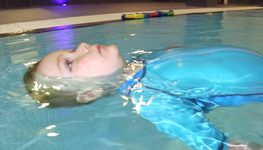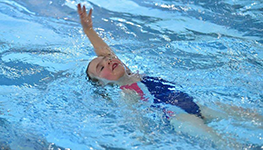Les Bébés Amphibies International believes every baby and child should know how to help themselves if they were ever to fall in the water alone as it only takes seconds for a fatal accident. For that reason our aquatic safety training is first on the list, with drowning still being the third highest cause of accidental death among children in the UK, at Bébés Amphibies we teach vital safety techniques from birth, so that babies are at home in the water.
In this first level your baby/child will learn how to float and later jump into the water, roll on to their back to stabilise and float. Once they can do this the next stage will be to teach them to do this fully clothed, including shoes and a winter coat, they learn to float like this for up to 20 minutes – depending on the age of the child. If a child falls into the water with clothes on it is very difficult to float if they have not learnt to do so.
Babies have a natural affinity with water, and they possess incredible natural reflexes in water: at Bébés Amphibies, we work with these to develop your child’s confidence and skills in the pool.
Babies have an automatic reflex of which stops them from breathing in water through their noses, when submerged into water, this allows them to keep their mouth wide open any water goes into their stomach and not into their lungs.
There’s a pattern to the way babies learn and the way their little bodies develop, and our lessons are all designed with this in mind. Babies have natural reflexes, we use these reflexes to teach them how to move around and swim. Babies learn very quickly and recognise word association and repetition and are soon able to recognise short commands of which we use to teach them to go underwater and to learn to swim on top of the water.
Each child is taken individually by our instructors who are fully qualified in teaching Aquatic Safety and Swimming Skills without buoyancy aids. Our teachers must have a nationally recognised, mainstream teaching qualification then they must attend “The Bébés Amphibies Int.” Training Course which involves a minimum 250/300 hours in the pool.
The parent will then be asked to repeat certain exercises during their lesson.
In Bébés Amphibies’ lessons there will be maximum of 4 babies per teacher in the water at any one time. All babies must always be accompanied by one of their parents or a responsible adult over the age of 18.




